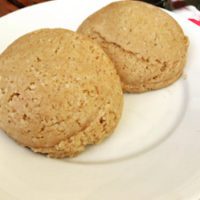Summer IBD Team Teaches 2 Week Entrepreneurial Course to Students in Harare, Zimbabwe
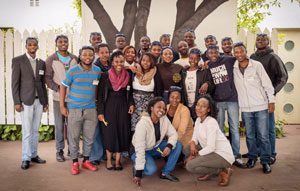 Written by Sampada Chavan, Kathryn Linarducci, Senthuran Raveendranathan, Yi Zhang, and Praveen Settipalli
Written by Sampada Chavan, Kathryn Linarducci, Senthuran Raveendranathan, Yi Zhang, and Praveen Settipalli
The Berkeley Haas IBD team finally arrived in Harare, Zimbabwe on Sunday, July 2 after over 30 hours of travel time. After a quick shower break, we were taken to the ACT headquarters where we met the 24 brilliant students who we will be teaching over the next two weeks.
ACT is a non-profit entrepreneurship development program that aims to build an entrepreneurial ecosystem in Zimbabwe. It was launched in 2014 and has developed in collaboration with several prior Haas IBD teams. This year’s ACT classroom training has expanded to 3-weeks in length. In the 1st week, students learn the fundamentals of design thinking, identify opportunities in the market, and form teams to address the issues identified. In the 2nd week, students take a break from  their own projects to participate in the inaugural corporate hackathon with ACT’s partner, Innscor, a parent company that owns well-known Zimbabwean consumer staples and durable products brands. Students will have the unique opportunity to present their innovative recommendations to Innscor executives. In the 3rd week, students will refocus on the own projects and learn core business skills such as marketing, leadership, strategy, and finance. They will make a final pitch of their project to the ACT Executive Team and local investors. Once students complete the training, they will be eligible for mentorship through ACT and potential seed funding for their own business ideas.
their own projects to participate in the inaugural corporate hackathon with ACT’s partner, Innscor, a parent company that owns well-known Zimbabwean consumer staples and durable products brands. Students will have the unique opportunity to present their innovative recommendations to Innscor executives. In the 3rd week, students will refocus on the own projects and learn core business skills such as marketing, leadership, strategy, and finance. They will make a final pitch of their project to the ACT Executive Team and local investors. Once students complete the training, they will be eligible for mentorship through ACT and potential seed funding for their own business ideas.

In addition to the Berkeley IBD team, which consists of team lead Praveen Settipalli (EWMBA Class of 2016) and (EWMBA Class of 2018) Sampada Chavan, Sen Raveendranathan, Kate Linarducci, and Yi Zhang, this year’s ACT teaching team also includes London Business School MBA student Zac Orlando, and former Haas FTMBA IBD students Dan Fishman and Sebastian Amenabar, who are primarily responsible for teaching the third week of classes when the EWMBA IBD team heads back to California.
The IBD team prepared diligently for 7 weeks prior to arriving in Harare, refining the curriculum, creating lesson plans and teaching materials, building out the corporate hackathon, and recommending a strategy for ACT to expand.
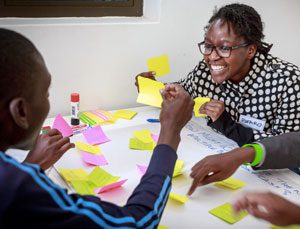 On Day 1, we introduced the students to design thinking by redesigning a wallet with the customer in mind. First, students shared and explained the contents of their wallet. Next, each student team converged on a particular item of interest and dug deeper into why and how to design for that item. The teams created prototypes, gathered feedback from the end user and refined their product. The final product was far different than the wallet that they started with. One team found that many people carried receipts in their wallet in order to budget and reconcile their daily spending. Instead of creating a new wallet better suited for carrying receipts, their proposed solution to eliminate receipts with a budgeting tool instead.
On Day 1, we introduced the students to design thinking by redesigning a wallet with the customer in mind. First, students shared and explained the contents of their wallet. Next, each student team converged on a particular item of interest and dug deeper into why and how to design for that item. The teams created prototypes, gathered feedback from the end user and refined their product. The final product was far different than the wallet that they started with. One team found that many people carried receipts in their wallet in order to budget and reconcile their daily spending. Instead of creating a new wallet better suited for carrying receipts, their proposed solution to eliminate receipts with a budgeting tool instead.
We also challenged students to be creative with limited resources. With only $2 of seed capital and 2 hours, students were asked to go out in the field to create value. Judges awarded the ingenuity of the winning team, who spoke to customers at a high-end supermarket to identify an opportunity to charge for smart shopping services to busy shoppers. They did not even use the $2 they were given. Taph Machirori, 30, reflected, “the $2 challenge taught me not to limit myself. I don’t need to be confined with the resources I think I have. Think outside of the box.”
 On Day 2, each student had one minute to present a need they see in the market today – these ranged from inefficiencies in the patient experience at hospitals and pharmacies to the lack of recycling in Zimbabwe. Students then voted on the presentation topics that interested them and teams were formed based on their voting preferences and leadership styles.
On Day 2, each student had one minute to present a need they see in the market today – these ranged from inefficiencies in the patient experience at hospitals and pharmacies to the lack of recycling in Zimbabwe. Students then voted on the presentation topics that interested them and teams were formed based on their voting preferences and leadership styles.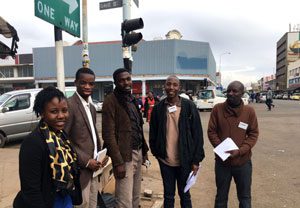
For the rest of the week, students learned design thinking through a combination of lectures and hands on experience working on their team project. The IBD team taught the students to diverge and converge as they framed and reframed the problem, tested their assumptions, brainstormed and narrowed down their ideas, and created their prototype.
 Student teams went out into the field during each step of the process to observe and conduct interviews to validate their assumptions, redefine their “how might we” statement, present their proposal, and receive feedback on their prototype. The Haas IBD instructors shadowed and mentored student teams throughout the week. Since the design thinking process is not a linear, often times teams were met with unexpected insights that led them to reconsider and pivot in a different direction.
Student teams went out into the field during each step of the process to observe and conduct interviews to validate their assumptions, redefine their “how might we” statement, present their proposal, and receive feedback on their prototype. The Haas IBD instructors shadowed and mentored student teams throughout the week. Since the design thinking process is not a linear, often times teams were met with unexpected insights that led them to reconsider and pivot in a different direction.
Knowing when to pivot is an important lesson in design thinking and students experienced this first  hand with the marshmallow exercise. Teams had 18 minutes to create the tallest free-standing structure possible using 1 meter of string, 1 meter of tape, 20 spaghettis, and 1 marshmallow. The marshmallow had to be at the top of the structure. The team that constructed the winning structure, at 20 inches, iterated several times with the placement of the marshmallow instead of waiting until the time was running out.
hand with the marshmallow exercise. Teams had 18 minutes to create the tallest free-standing structure possible using 1 meter of string, 1 meter of tape, 20 spaghettis, and 1 marshmallow. The marshmallow had to be at the top of the structure. The team that constructed the winning structure, at 20 inches, iterated several times with the placement of the marshmallow instead of waiting until the time was running out.
At the conclusion of the first week of classes, students expressed their excitement for what they had learned. Gilbert Kumusasa, 27, shared, “even at home, everyone has seen the change in the way I think about things. There’s no limit to anything we can do: be it at home, at work, at social settings. We can use this design thinking process to look at problems and come up with innovative solutions.”
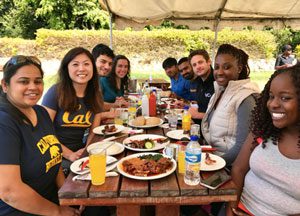 After a long week of teaching and learning, the IBD/ACT team got a taste of Zimbabwean culture on our day off. We enjoyed a leisurely meal of sadza (Zimbabwean typical staple food made out of cornmeal) and stews, which are eaten with your hands. Lunch was so delicious and filling that we decided to walk it off at Domboshava, a granite hill just outside of Harare with ancient cave paintings and spectacular balance rocks.
After a long week of teaching and learning, the IBD/ACT team got a taste of Zimbabwean culture on our day off. We enjoyed a leisurely meal of sadza (Zimbabwean typical staple food made out of cornmeal) and stews, which are eaten with your hands. Lunch was so delicious and filling that we decided to walk it off at Domboshava, a granite hill just outside of Harare with ancient cave paintings and spectacular balance rocks.


